State Farm Bundle
How Does State Farm Thrive in the Insurance Arena?
State Farm, a titan in the U.S. financial services landscape, isn't just an insurance company; it's a massive operation serving millions. As the nation's largest provider of auto and home insurance, understanding its inner workings is key. From its impressive financial turnaround in 2024 to its vast array of offerings, State Farm's influence is undeniable.
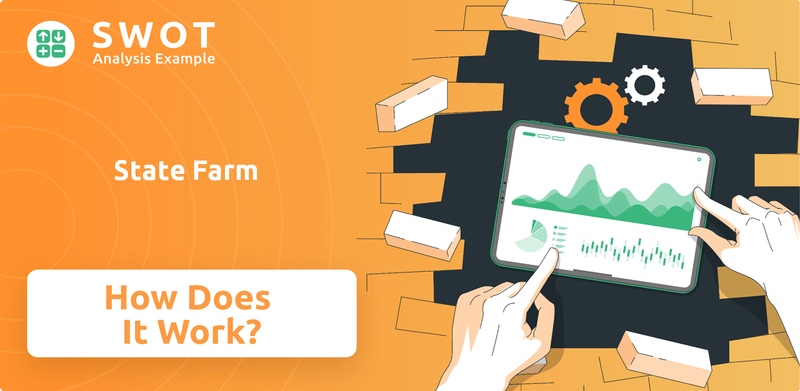
Delving into the operational strategies of State Farm SWOT Analysis, this exploration will uncover its diverse revenue streams and competitive advantages. We'll examine how this insurance company navigates market dynamics, providing insights for investors and customers alike. Whether you're curious about State Farm coverage options, the State Farm insurance claims process, or simply how to get a quote, this analysis offers a comprehensive view of a financial services powerhouse.
What Are the Key Operations Driving State Farm’s Success?
The core operations of State Farm revolve around providing a broad spectrum of insurance and financial services. This approach aims to assist individuals and businesses in managing everyday risks and recovering from unexpected events. The company's primary offerings include auto, home, life, and health insurance, alongside banking and investment services.
State Farm primarily serves customers across the United States, utilizing a vast network of agents to reach its customer base. The company focuses on delivering exceptional customer service and personalized claims handling. This strategy is designed to build long-term loyalty and trust among its clients.
State Farm's value proposition lies in its ability to offer comprehensive coverage options and accessibility through a large agent force. The company is committed to helping customers recover from unforeseen circumstances, providing a sense of security and support during challenging times. This commitment is a key differentiator within the insurance market.
State Farm offers a wide range of insurance products, including auto, home, life, and health insurance. They also provide banking and investment services. This comprehensive approach allows customers to manage various financial needs under one roof.
The operational processes include underwriting policies, assessing risks, and processing claims. State Farm utilizes a network of over 19,400 agents to facilitate sales and foster personalized relationships. They invest heavily in technology and data analytics to improve service offerings.
State Farm emphasizes exceptional customer service and personalized claims handling. This approach aims to build long-term loyalty and trust. Their commitment to customer satisfaction is a key part of their business strategy.
State Farm implements DevOps pipelines and practices, including on IBM Z, to accelerate the development of new digital services. This helps standardize development approaches across the enterprise. This focus on technology enhances the customer experience.
State Farm distinguishes itself through a hybrid approach, combining a strong agent-based distribution model with increasing digital capabilities. This strategy allows them to cater to diverse customer preferences. This dual approach provides both personal interaction and convenient self-service options.
- Extensive Agent Network: Over 19,400 agents provide a localized and personal touch.
- Digital Platforms: User-friendly websites and mobile apps enhance the customer experience.
- Customer Benefits: Broad coverage options and a commitment to helping customers recover from unforeseen circumstances.
- Competitive Analysis: For a deeper understanding of the competitive landscape, see Competitors Landscape of State Farm.
State Farm SWOT Analysis
- Complete SWOT Breakdown
- Fully Customizable
- Editable in Excel & Word
- Professional Formatting
- Investor-Ready Format
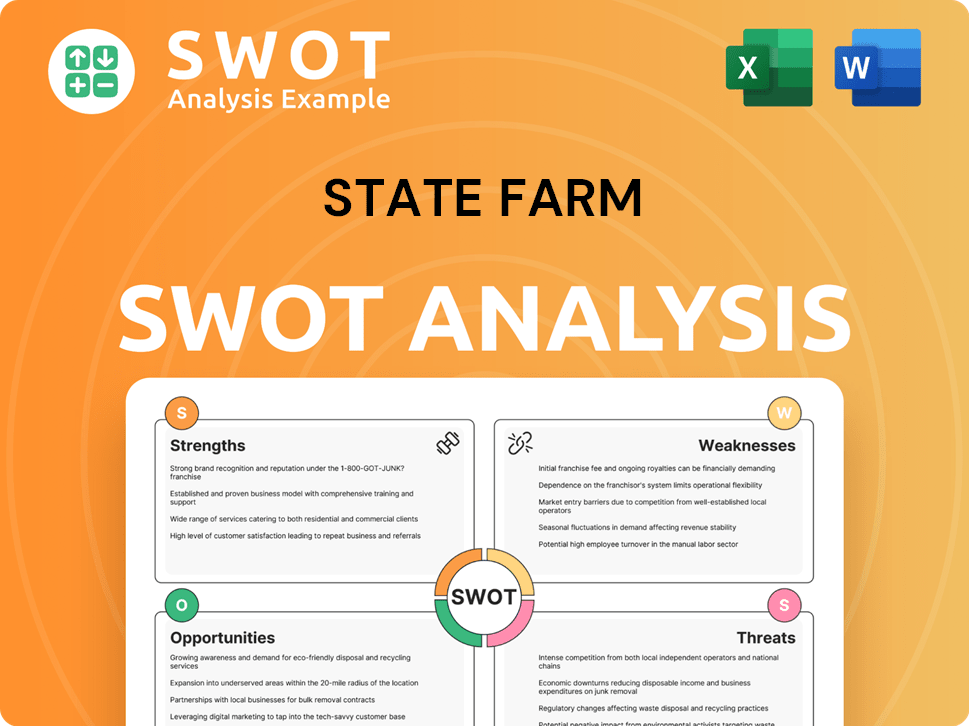
How Does State Farm Make Money?
The revenue model of State Farm is primarily built on insurance premiums, but it is significantly enhanced by investment income. In 2024, the total revenue of the company, including premium revenue, investment income, and realized capital gains (losses), reached $123.0 billion. This marks an impressive 18.0% increase from the $104.2 billion reported in 2023.
State Farm's financial strategy goes beyond just collecting premiums; it involves a diversified approach to generate income and maintain financial stability. This includes strategic investments and the provision of financial services, making it a comprehensive financial services provider.
This approach allows State Farm to offer a wide array of services, enhancing customer relationships and driving revenue growth. The company’s ability to adapt and innovate within the insurance and financial services sectors is a key driver of its success.
Insurance premiums are the main source of income for State Farm, with significant contributions from both property and casualty (P-C) and life insurance lines. The P-C group reported earned premiums of $103.0 billion in 2024.
Auto insurance is a major component of State Farm's P-C business. It represents a substantial portion of the company’s revenue. In 2024, auto insurance alone accounted for 65% of the P-C companies' combined net written premium, with earned premiums of $67.5 billion.
Homeowners and other property lines are also significant contributors to State Farm's revenue. This segment provides a substantial income stream, reflecting the company’s diverse insurance offerings. Homeowners and other property lines contributed $34.5 billion in earned premiums in 2024.
Life insurance premiums add to the revenue streams. The life insurance companies reported premium income of $6.7 billion in 2024, demonstrating the company’s presence in the life insurance market.
Investment income is crucial for State Farm, generated by investing the premiums collected before claims are paid. This strategy is standard in the insurance industry and strengthens the company's financial position.
Realized capital gains also significantly impact State Farm's profitability. In 2024, the net income of $5.3 billion included $3.0 billion in realized capital gains, net of tax. This highlights the importance of investment performance.
State Farm employs various monetization strategies to maximize its revenue. This includes cross-selling, offering bundled services, and leveraging customer data to enhance customer relationships and drive sales. The company's move to offer a comprehensive approach to insurance and financial planning encourages cross-selling.
- Cross-selling: Encouraging customers to purchase multiple products, such as auto and home insurance, to increase revenue per customer.
- Bundled Services: Offering combined insurance and financial products to provide a one-stop solution for customers.
- Customer Data: Utilizing customer data to personalize offerings and improve marketing effectiveness.
- Financial Services: Providing financial services like banking and investment planning, contributing to revenue through fees and interest. The total assets under management for Investment Planning Services were $15.2 billion at the end of 2024.
State Farm PESTLE Analysis
- Covers All 6 PESTLE Categories
- No Research Needed – Save Hours of Work
- Built by Experts, Trusted by Consultants
- Instant Download, Ready to Use
- 100% Editable, Fully Customizable
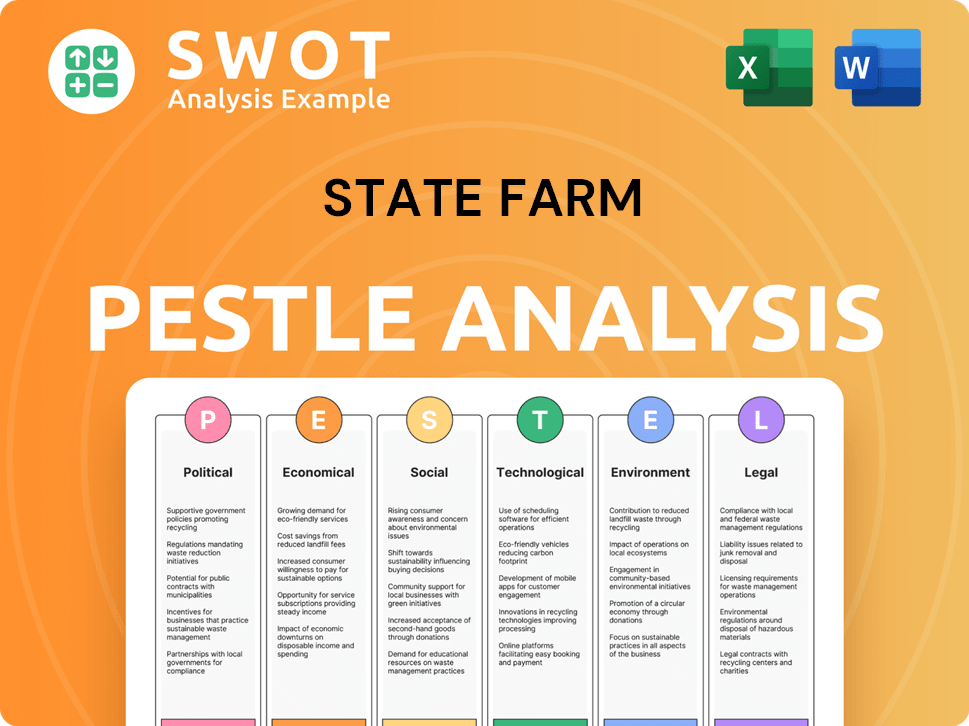
Which Strategic Decisions Have Shaped State Farm’s Business Model?
The operational and financial journey of State Farm has been shaped by significant milestones and strategic decisions. A key focus involves its commitment to digital transformation, investing in digital platforms and tools to improve customer experience and streamline operations. This includes mobile innovations and continually updating online platforms to make it easier for customers to get quotes, file claims, or find agents.
State Farm also embraces partnerships with tech companies and investments in startups to stay ahead of competition and meet evolving customer needs. These strategic moves are crucial for maintaining its position in the competitive insurance market. The company continuously adapts to new trends and technology shifts by investing in digital transformation and strategic partnerships.
As the largest provider of auto and home insurance in the U.S., State Farm's brand recognition and 'good neighbor' image are powerful assets. The vast network of over 19,400 agents provides a localized presence and personalized service that differentiates it from purely online competitors. Its scale allows for significant investment in technology and data analytics to improve services and efficiency. For a deeper understanding of their approach, consider exploring the Marketing Strategy of State Farm.
State Farm's history is marked by several key milestones. These include its founding in 1922, initially focusing on auto insurance. Over the years, it expanded to offer a wide range of insurance products, including home insurance, life insurance, and financial services. This expansion has been crucial to its growth and market dominance.
Strategic moves include a significant investment in digital platforms to enhance customer experience and streamline operations. This involves mobile innovations and continually updating online platforms to make it easier for customers to get quotes, file claims, or find agents. Partnerships with tech companies and investments in startups are also key.
State Farm's competitive advantages are rooted in its strong brand strength, extensive agent network, and economies of scale. As the largest provider of auto and home insurance in the U.S., its brand recognition and 'good neighbor' image are powerful assets. The vast network of over 19,400 agents provides a localized presence and personalized service.
Operational and market challenges have significantly impacted State Farm. The company has faced continued elevated claims severity and significant catastrophe activity, leading to substantial underwriting losses. For example, in 2024, the P-C group reported a combined underwriting loss of $6.1 billion, though this was an improvement from the $14.1 billion loss in 2023.
In 2024, the auto insurance business, representing 65% of P-C net written premium, saw its underwriting loss decrease to $2.7 billion from $9.7 billion in 2023. However, challenges persist, particularly in California, where State Farm General Insurance Company has faced significant capital deterioration due to weak underwriting performance and substantial wildfire losses.
- State Farm General announced non-renewals for some 72,000 California policies in March 2024.
- The company has sought emergency rate increases in California, with a request for an average rate hike of 22% effective May 1, 2025.
- The company is transitioning auto glass claims administration to Safelite Solutions starting July 1, 2025.
- State Farm's commitment to digital transformation includes mobile innovations and continual updates to online platforms.
State Farm Business Model Canvas
- Complete 9-Block Business Model Canvas
- Effortlessly Communicate Your Business Strategy
- Investor-Ready BMC Format
- 100% Editable and Customizable
- Clear and Structured Layout
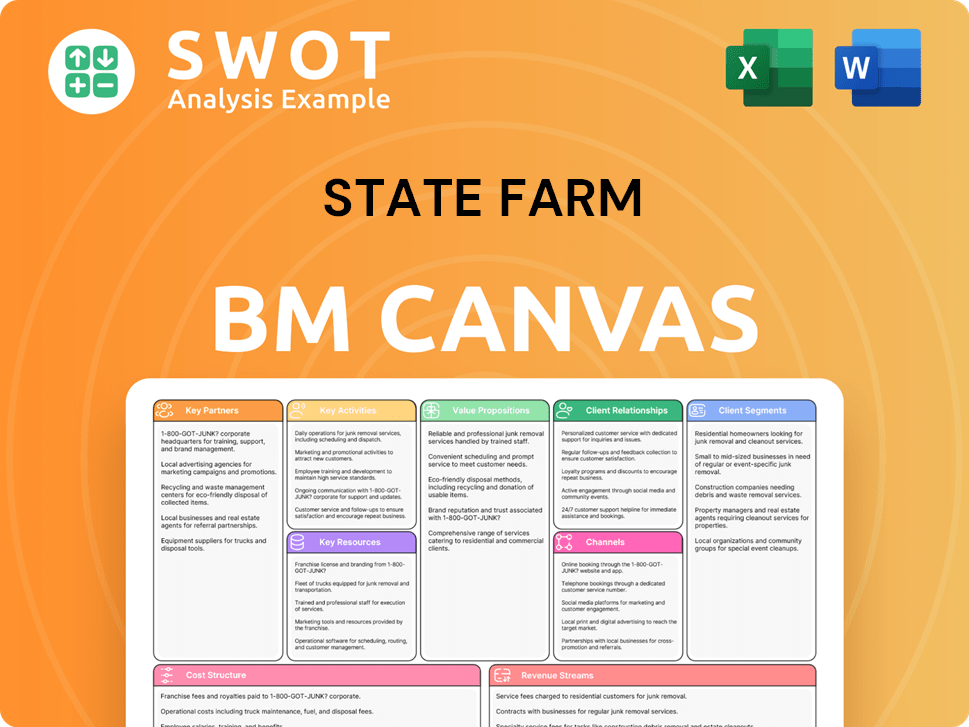
How Is State Farm Positioning Itself for Continued Success?
The insurance industry in the United States sees State Farm as a major player. As the biggest provider of car and home insurance in the U.S., it looks after over 91 million policies and accounts. In 2025, State Farm led the U.S. auto insurance market for the third year in a row, with about $68 billion in direct premiums written and a market share of 18.9%, up from 18.3% in 2024. For homeowners, it held roughly 19.4% of all direct premiums collected by U.S. underwriters in 2024. As of March 2024, State Farm Group had a 9.82% market share across all P&C lines, making it the largest overall P&C insurer in the U.S.
Despite its strong position, State Farm faces several challenges. Regulatory changes, especially in states like California, create difficulties. The company has trouble getting rate approvals to offset rising claims costs, leading to losses and policy cancellations in some areas. Rising claims costs due to inflation, supply chain issues, and more frequent disasters (like wildfires) also affect its profitability. New competitors and technological advances present ongoing risks as well.
State Farm is the leading insurance company in the U.S. for both auto and home insurance. It holds a significant market share, demonstrating its strong presence. The company's extensive customer base reflects its widespread reach and influence in the insurance sector.
Regulatory changes and difficulties in obtaining rate approvals pose challenges. Rising claims costs due to inflation and disasters impact profitability. New competitors and technological advancements create ongoing risks for State Farm insurance.
State Farm focuses on a 'state-specific approach' to address local market conditions. Digital transformation and innovation are key to improving customer experience. The company aims to maintain its leadership by adapting to market changes and managing risks effectively.
The company is committed to digital transformation to enhance customer service and operational efficiency. Financial strength is emphasized to fulfill promises to customers and expand service offerings. State Farm plans to leverage its scale and brand to maintain its leadership position in the competitive State Farm coverage landscape.
State Farm must navigate regulatory hurdles and manage increasing claims costs. Adapting to technological changes and competition is crucial for future success. The company's strategic initiatives focus on operational efficiency and customer service enhancements.
- Focus on digital transformation to improve customer experience.
- Implement a state-specific approach to address local challenges.
- Maintain financial strength to fulfill customer promises.
- Adapt to evolving market conditions and manage risks effectively.
State Farm Porter's Five Forces Analysis
- Covers All 5 Competitive Forces in Detail
- Structured for Consultants, Students, and Founders
- 100% Editable in Microsoft Word & Excel
- Instant Digital Download – Use Immediately
- Compatible with Mac & PC – Fully Unlocked
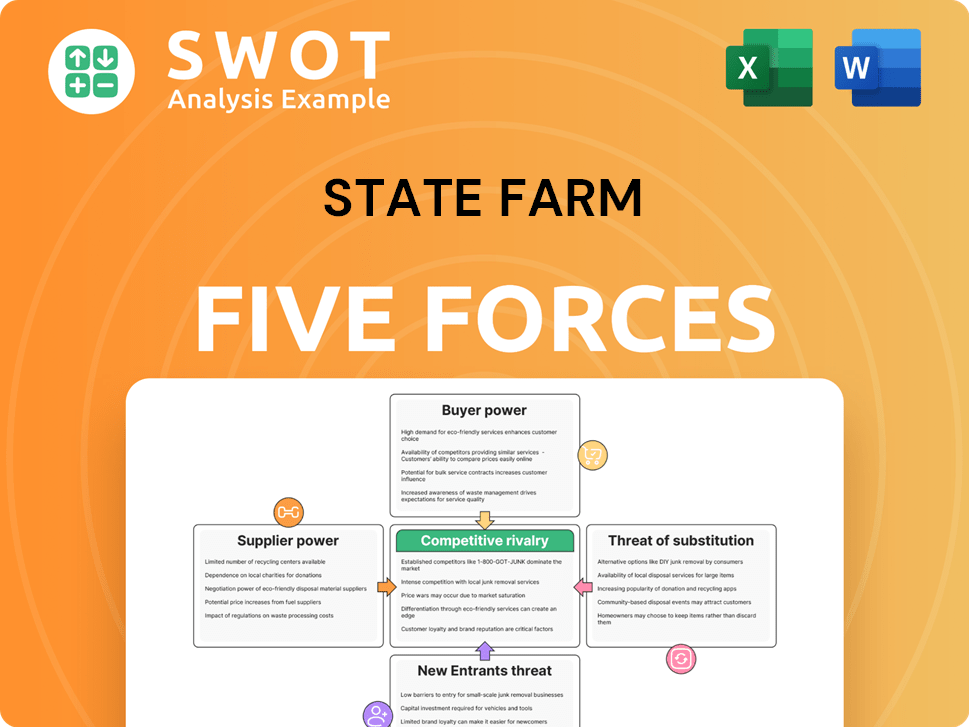
Related Blogs
- What are Mission Vision & Core Values of State Farm Company?
- What is Competitive Landscape of State Farm Company?
- What is Growth Strategy and Future Prospects of State Farm Company?
- What is Sales and Marketing Strategy of State Farm Company?
- What is Brief History of State Farm Company?
- Who Owns State Farm Company?
- What is Customer Demographics and Target Market of State Farm Company?
Disclaimer
All information, articles, and product details provided on this website are for general informational and educational purposes only. We do not claim any ownership over, nor do we intend to infringe upon, any trademarks, copyrights, logos, brand names, or other intellectual property mentioned or depicted on this site. Such intellectual property remains the property of its respective owners, and any references here are made solely for identification or informational purposes, without implying any affiliation, endorsement, or partnership.
We make no representations or warranties, express or implied, regarding the accuracy, completeness, or suitability of any content or products presented. Nothing on this website should be construed as legal, tax, investment, financial, medical, or other professional advice. In addition, no part of this site—including articles or product references—constitutes a solicitation, recommendation, endorsement, advertisement, or offer to buy or sell any securities, franchises, or other financial instruments, particularly in jurisdictions where such activity would be unlawful.
All content is of a general nature and may not address the specific circumstances of any individual or entity. It is not a substitute for professional advice or services. Any actions you take based on the information provided here are strictly at your own risk. You accept full responsibility for any decisions or outcomes arising from your use of this website and agree to release us from any liability in connection with your use of, or reliance upon, the content or products found herein.